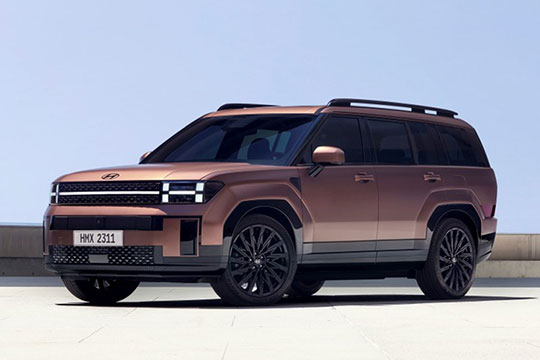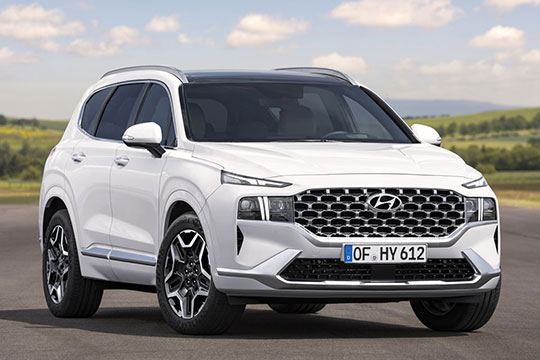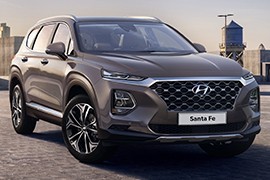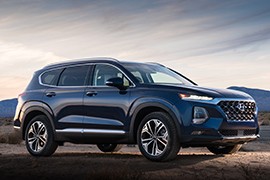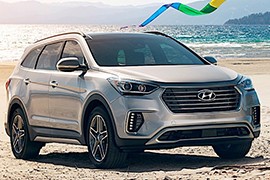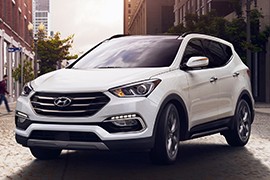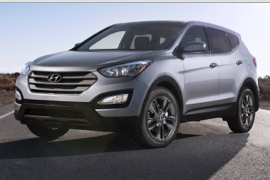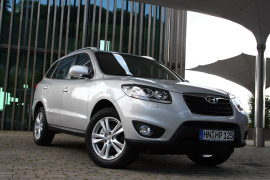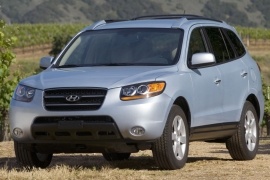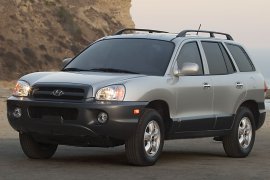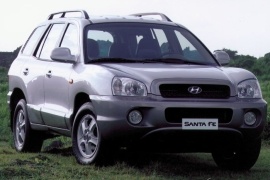HYUNDAI Santa Fe Models/Series Timeline, Specifications & Photos
First production year: 2000
Engines: Hybrid gasoline, Gasoline, Diesel
Body style: SUV (Sports Utility Vehicle)
Hyundai shook the world in 2023 when it introduced the fifth generation of its Santa Fe SUV, surprising its competitors with a bold-looking vehicle that was completely different than its predecessors. Moreover, not only that it was a larger vehicle, but it was more luxurious and garnished with all the bells and whistles that an upscale car could offer. Still, it wasn't considered a premium SUV but a mass-market one. One that could've been used on a daily urban commute and on weekends for a camping trip.
Hyundai was eager to introduce the fifth generation of the Santa Fe. The Korean automaker sent the previous generation to retirement after just five years, which was uncommon for the car's segment. But seeing the new model, it was quite understandable. The fifth Santa Fe offered a demanding look on the road, featuring a flat front fascia. Its headlights were dispersed in an unusual pattern and connected by a light strip that crossed the car's main grille from side to side. Gone were the rounded, soft shapes of its predecessor. The 2024 Santa Fe featured straight cuts for the lower side intakes and the lower grille. Moreover, from its profile, the SUV boasted flared wheel arches that created the impression of a rugged off-road vehicle. To make the car look more dynamic, the designers made a slightly descending roof line, and the last two pillars were almost vertical. But while the front and the sides of the vehicle looked very bold, the rear fascia didn't impress too much due to its lower light panel that crossed the tailgate. The proportions between the glass area and the metallic panels were not that much pleasant. But it was a form that followed function, and for that, Hyundai had to be forgiven.
Inside, the almost vertical side panels and the long cabin offered plenty of room for those who loved camping in nature and didn't want to sleep in a tent. The Santa Fe was available with two or three rows of seats, and by folding all but the first ones, it created a completely flat surface where at least two people could sleep in comfort. For daily use, though, the automaker prepared a well-equipped dashboard with a digital instrument cluster for the driver and a 12.3" touchscreen placed atop the center stack for the infotainment system. These two formed a panoramic curved display with a seamless integration behind the same piece of glass. Fortunately, the main audio controls and the HVAC unit kept their physical buttons in place.
Under the hood, Hyundai installed a choice of two hybrid drivetrains powered by either a 1.6-liter or a 2.5-liter gasoline unit. Both were carried over from the previous generation of the Santa Fe.
After just three years on the market for the fourth generation of the Santa Fe, Hyundai revealed the facelifted version in 2020. It brought new features and new technologies for their mid-size SUV.
The Korean car-manufacturer brought the facelifted model just in time for the 20th anniversary. The achievements got to the car in the past two decades transformed and evolved the Santa Fe from a compact to a mid-size vehicle.
From the outside, the exterior design combined rugged features with sophisticated lines. On the front fascia, the distinctive wide grille with a 3D pattern made the car looks robust. The T-shaped LED daytime running lights created a light signature for the vehicle. On the lower side of the bumper, the manufacturer installed a shield under the lower air-intake. The wheel-arches featured plastic molds in body color. The rear bumper was redesigned. A set of 20” light-alloy wheels was available as an option.
Inside, the Santa Fe offered a roomier interior for its passengers. The lower dashboard showed an airy feeling for the passengers, while the driver could enjoy the optional 12.3” digital cluster. A 10.25” touch-screen for the infotainment unit decorated the center stack. Due to the new D-platform, the Santa Fe offered more room for the rear passengers.
With great success with the past Santa Fe models, Hyundai revealed the forth generation in 2018.
The new model brought a more modern design given by the sharper lines.
The 3-row SUV was a good match for larger families with a great mix of features and comfort for an affordable price.
The Santa Fe could accommodate up to 7 passengers and was available in three trim levels: the SE, SE Ultimate and the Limited Ultimate.
The base model offered LED running lights, heated side mirrors, 18-inch alloys, a rear-view camera, a 7-inch infotainment display and automatic climate control. AppleCar play and Android Auto were also included.
Easy to differentiate from the SE, the SE ultimate added 19-inch wheels, LED foglight, a sunroof, leather seating, heated seats and steering wheel, as well as ventilated from seats. The display was enlarged to 8-inch and the upgraded audio system included 12 speakers.
The top of the range, the Limited Ultimate was an SE Ultimate with a chairs instead of the 2nd row bench.
Available for the SE Ultimate and the Limited Ultimate was a Tech Package that included more safety features such as adaptive cruise control, forward collision warning and mitigation, a lane departure warning and xenon headlights with automatic high beams.
The interior provided great comfort and adjustability, with plenty of legroom and headroom. The 3rd row was suitable for kids.
HYUNDAI Santa Fe 2.0L CRDI 6MT (150 HP)
HYUNDAI Santa Fe 2.0L CRDI 6MT (185 HP)
HYUNDAI Santa Fe 2.0L CRDI 6MT AWD (150 HP)
HYUNDAI Santa Fe 2.0L CRDI 6MT AWD (185 HP)
HYUNDAI Santa Fe 2.0L CRDI 8AT AWD (150 HP)
HYUNDAI Santa Fe 2.0L CRDI 8AT AWD (185 HP)
HYUNDAI Santa Fe 2.2L CRDi 6MT awd (200 HP)
Introduced in the summer of 2018, the Korean vehicle had the difficult job of continuing the Santa Fe's nameplate on top of Hyundai's best-selling SUV.
The fourth generation of Santa Fe was traditionally launched in Korea, and it reached other markets only after that. Europeans got their version in March 2018 at the Geneva Motor Show, while U.S. customers had to wait for it until the summer of that year.
One of the most striking news for the car was the introduction of a completely new design concept for the front fascia. Its new cascade grille was flanked by the main headlights, while above them were the DRLs. On the sides, the design team added sculptured door panels that created the image of a longer vehicle. This short wheelbase version of the Santa Fe also lost the "Sport" moniker used on the previous model. Finally, at the back, the V-shaped taillights crossed emerged on the tailgate from the quarter panels.
But the real improvement for the SUV was noticed on the inside. The dashboard featured a clean design, with a standard 7" infotainment touchscreen placed above the center stack. The driver had access to an instrument cluster that was available as a TFT display. In addition, a head-up display was on the options list. Most versions came fitted with heated front seats. Apart from the standard cloth upholstery, Hyundai also offered a leather-wrapped interior. The split-folding (60/40) rear bench at the back could also recline for better comfort on long travels.
Under the hood, Hyundai offered a choice of turbocharged gasoline or diesel engines. They were all paired with an eight-speed automatic transmission and sent the torque in all corners.
While not part of the category's leaders, mostly because of the lack of name recognition, the Santa Fe offered nearly as much as the premium brands offered, for a lower price.
Besides offering seating for 7 with the 3rd extra row, the Santa Fe was well equipped even in its standard version with alloy wheels, LED daytime running lights, a rear-view camera and dual-zone automatic climate control.
Compared to the alternatives on the market, the 3rd row was a little cramped and the cargo capacity was reduced, but other than that, the Santa Fe was a great fit for larger families.
For 2017, the Hyundai Santa Fe was available in four trim levels: Se, Limited, SE Ultimate and Limited Ultimate.
All versions were equipped with the latest technologies available for enhanced comfort, practicality and convenience, such as dark-tinted rear privacy glass, roof rack side rails, power driver seat, Bluetooth connectivity, a 7-inch touchscreen display, Hyundai’s Blue Link system, Android Auto, keyless go, blind-sport warning with rear cross-traffic alert, lane departure warning, leather upholstery and others depending on the trim level.
With the range-topping SE Ultimate and Limited Ultimate, the Santa Fe featured 19-inch alloys, a 360 degree multi view camera system, a panoramic sunroof, heated and ventilated front seats, a heated steering wheel, a navigation system and a bigger 8-inch touchscreen display, as well as a premium sound system.
All powertrains offered came with the new Drive Mode selection including the Sport, Eco and Normal settings. Available with a front- or an all-wheel-drive system, the new model came with a choice of 3 engines, depending on the seating configuration.
Hyundai offered a special version named "Sport" for the U.S. market, which meant more than just a new badge on the tailgate.
At the New York International Auto show, Hyundai introduced the fourth generation of the Santa Fe in 2012. For some markets, such as the U.S., the Korean SUV was available in a choice of two wheelbases. The shorter version received the "Sport" suffix, and it was a two-row seat affair only. But fast forward another four years, and the entire Santa Fe lineup has received a facelifted version. No less than 350 parts from the car were changed or upgraded, which counted for about 25% of the vehicle's parts.
The front fascia was radically upgraded and received a new bumper incorporating lower-mounted fog lamps. In addition, a set of new, horizontal daytime running lights with LED technology enhanced the car's look. Moreover, the automaker installed new HID Xenon headlights with LED accents. Also, the back of the vehicle was changed by introducing a restyled bumper and new taillights. In addition, the automaker also revised the alloy wheels options.
Inside, the Santa Fe Sport got an updated 12-Speaker Infinity Logic7 sound system connected to a touchscreen mounted atop the center stack. In addition, the new infotainment unit boasted Android Auto compatibility. To make the interior even brighter, the automaker offered a panoramic sunroof. As an option, the Sport version also got a hands-free tailgate opening.
Under the hood, the Korean SUV offered a choice of two inline-four gasoline engines paired with a standard six-speed automatic gearbox. Last but not least, Hyundai provided the Santa Fe Sport with either front- or all-wheel drive systems.
The third generation of the Santa Fe moved on from a dull appearance into a bolder look with a big grille on the front. But it kept its original values for affordability and comfort.
It had seats for up to seven passengers and features that could be found in more expensive SUVs on the market. The Santa Fe was a reliable car according to JD Power surveys and in proper color choice, it looked more like a premium vehicle.
The aggressive look on the front might not be the right choice for a family SUV, but that was the trend when it was launched in 2012. The big grille featured three chromed horizontal lines swept backward on the sides, to nicely blend into the front fascia. On the bumper, the big fog-lights were placed unusually high for such features, and the ascending beltline gave the impression of agility.
Inside, depending on the trim level, Hyundai decided to install a new infotainment unit with reverse camera, navigation, and a decent sound system with USB ports, AUX-in and Bluetooth connection. The connectivity with the mobile phone was offered from the base trim level.
The Santa Fe was offered with a variety of diesel and gasoline engines, depending on the market. While the main choice in Europe was the 2.2-liter diesel unit, on other markets there was a wider choice for gasoline engines. In its top-spec version, it was equipped with a strong, 3,3-liter V6 that offered 290 hp. Depending on the version, the 2012 Santa Fe was available with a 2 or 4-wheel-drive system. But all of them featured all-wheel independent suspension.
Hyundai introduced the second generation of the Santa Fe in 2005 in South Korea and, two years later, on foreign markets but by 2009, it had to update the SUV to comply with the Euro 5 emission standards.
The Korean carmaker had a tough time when it tried to enter the SUV segment. While the first Santa Fe generation was characterized mostly by being dull, the second generation grabbed more attention to it. There was a new design language and, also, the price was lower than many of its competitors.
Along with the facelift, the carmaker changed the front fascia and added sharper-looking headlights and a new bumper. A wider A-shaped lower grille flanked by foglights increased the overall aggressive look. Meanwhile, a thicker chromed slat adorned the upper side of the main grille, mounted between the headlights. But Hyundai didn't want to promote a rugged, off-road look. It aimed mostly at those looking for a family vehicle but were not satisfied with regular station wagons.
Inside, the 2009 Santa Fe featured new materials and an improved design. Yet, the seating position remained high and offered a safe sensation for the driver and other occupants. Thanks to that, there was plenty of room for five adult passengers. Even the center tunnel needed for the transmission was low enough and didn't represent an issue for the rear occupants.
Under the hood, the main powerplant for Europe was a 2.2-liter turbodiesel with Diesel Particulate Filter (Euro 5), while other countries had to rely on the 2.7-liter V6 gasoline unit.
Hyundai introduced the second generation of the Santa Fe SUV in 2005 for the Korean market but unveiled it for the rest of the world after the 2006 North American International Auto Show.
Hyundai was an already known player in the SUV market thanks to the Tucson and Santa Fe's first-generation. These were built for those who didn't like the MPVs but needed more room than a regular station wagon could offer.
With the 2006 model, Hyundai fixed the design issue and came with completely different styling. It followed the bio-design trend, even though it was already dead for most of the world. But its swept-back headlights, its curved surfaces, and ascending beltline conquered plenty of customers. It looked friendly rather than rugged.
Inside, Hyundai offered an option for seven seats, and that added more value to the car. Most buyers didn't need that, but they still bought it "just in case." The interior offered a car-like design, with soft lines, a center stack with tall vents on its sides, and a center console tall enough to separate the front passengers. The Santa Fe offered enough room for three adults in the middle row thanks to its almost flat floor. Two adults might have been squeezed in the last row, but for short (very short!) distances.
Under the hood, Hyundai installed a choice of three engines, depending on the market. While the American market received the 3.3-liter V-6 engine, Europe had to rely on the 2.2-liter turbo-diesel, which was noisy and slow but fuel-efficient. The 2.7-liter, on the other hand, was on any market. Most importantly, the Korean carmaker offered the Santa Fe with a front- or permanent all-wheel-drive.
Hyundai took a bold decision and introduced the first generation of the Santa Fe SUV in 2001 as part of its plan to expand on all car segments.
While the customers were looking for experienced 4x4 builders such as Nissan, Toyota, Jeep, or Ford, the newcomers such as BMW, Honda, and Volvo were trying hard to make their way onto the market. Hyundai built the Santa Fe, but neither its design team nor the engineering department had enough SUV building experience. In 2004, Hyundai refreshed the Santa Fe's first generation.
For the 2005 model, Hyundai removed the radio's antenna from the drier's rear-side window to the roof. Most trim levels received body-colored bumpers and side moldings. The Korean carmaker introduced the side-steps for the upper trim level as a standard feature.
Inside, Hyundai refreshed the instrument cluster and added new silver rings around the four-dial panels. Its high-mounted seats made led to better legroom for the rear passengers than in the Sonata. Thanks to the split-folding rear bench, the trunk could increase its size from a regular 850 liters (30.2 cu-ft) to an excellent 2,100 liters (74.16 cu-ft). The carmaker installed an opening rear windscreen to the tailgate to ease the loading and unloading of small items.
Under the hood, the 2004 Santa Fe dropped the 3.5-liter gasoline engine and kept only the smaller, 2.7-liter unit. Besides that, it used two fuel-efficient turbo-diesel units.
It was the dawn of a new era for the Korean carmaker: it entered the SUV segment with a bold statement shown in the form of the Santa Fe.
The world was ready to take the next step and trade the MPV for the SUV vehicles, which proved to be more trustworthy in snowy conditions. It was a new trend, and slowly, many carmakers that didn't have any experience in that domain took the light off-road vehicles path. Hyundai was one of them, and it built the Santa Fe on the same platform as the Sonata.
While its design was not a masterpiece, it was the car that waited for many customers. Its look was a mix between an off-road vehicle and a sedan. Its curved lines seemed out of place on a 4x4 vehicle, and its height was unfitted for a station wagon. Hyundai listened to its customers and made several modifications almost on a yearly basis. Its wrapped-around, black, plastic bumpers received body-color treatment.
Inside, the car was roomier than a Sonata, which wasn't a small car anyway. It offered plenty of headroom and a big trunk, which could have been extended by folding down the rear bench's seatback. Even on the base version, the car featured air-conditioning and a CD-stereo. A sunroof became available starting in 2002. The carmaker continued to improve the car until 2005 when it changed the generation.
Technically, the Santa Fe was constantly improved as well. It started with a fuel-efficient 2.4-liter engine for the U.S. market and a 2.0-liter turbo-diesel for the European market. It wasn't everyone's vanilla, but at least it had a flavor that could fit more tastes—something like coffee.
